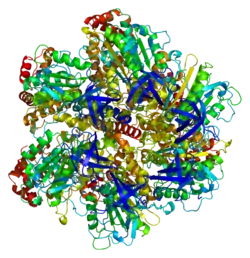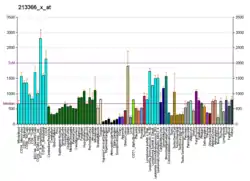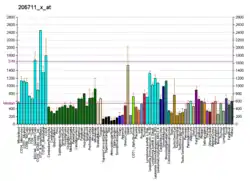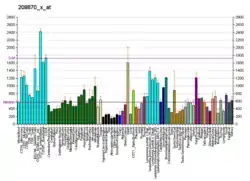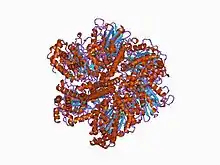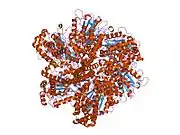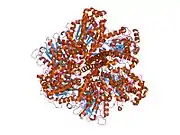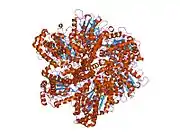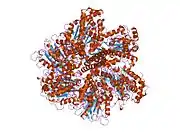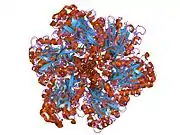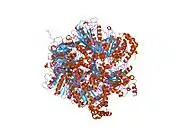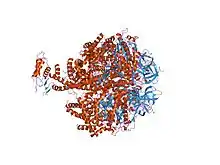ATP5C1
The human ATP5F1C gene encodes the gamma subunit of an enzyme called mitochondrial ATP synthase.[5][6][7]
This gene encodes a subunit of mitochondrial ATP synthase. Mitochondrial ATP synthase catalyzes adenosine triphosphate (ATP) synthesis, utilizing an electrochemical gradient of protons across the inner membrane during oxidative phosphorylation. ATP synthase is composed of two linked multi-subunit complexes: the soluble catalytic core, F1, and the membrane-spanning component, F0, comprising the proton channel. The catalytic portion of mitochondrial ATP synthase consists of 5 different subunits (alpha, beta, gamma, delta, and epsilon) assembled with a stoichiometry of 3 alpha, 3 beta, and a single representative of the other 3. The proton channel consists of three main subunits (a, b, c). This gene encodes the gamma subunit of the catalytic core. Alternatively spliced transcript variants encoding different isoforms have been identified. This gene also has a pseudogene on chromosome 14.[7]
References
- GRCh38: Ensembl release 89: ENSG00000165629 - Ensembl, May 2017
- GRCm38: Ensembl release 89: ENSMUSG00000025781 - Ensembl, May 2017
- "Human PubMed Reference:". National Center for Biotechnology Information, U.S. National Library of Medicine.
- "Mouse PubMed Reference:". National Center for Biotechnology Information, U.S. National Library of Medicine.
- Jabs EW, Thomas PJ, Bernstein M, Coss C, Ferreira GC, Pedersen PL (Jun 1994). "Chromosomal localization of genes required for the terminal steps of oxidative metabolism: alpha and gamma subunits of ATP synthase and the phosphate carrier". Hum Genet. 93 (5): 600–2. doi:10.1007/bf00202832. PMID 8168843. S2CID 39597611.
- Matsuda C, Endo H, Ohta S, Kagawa Y (Dec 1993). "Gene structure of human mitochondrial ATP synthase gamma-subunit. Tissue specificity produced by alternative RNA splicing". J Biol Chem. 268 (33): 24950–8. PMID 8227057.
- "Entrez Gene: ATP5F1C ATP synthase F1 subunit gamma".
External links
Further reading
- Yoshida M, Muneyuki E, Hisabori T (2001). "ATP synthase--a marvellous rotary engine of the cell". Nat. Rev. Mol. Cell Biol. 2 (9): 669–77. doi:10.1038/35089509. PMID 11533724. S2CID 3926411.
- Abrahams JP, Leslie AG, Lutter R, Walker JE (1994). "Structure at 2.8 A resolution of F1-ATPase from bovine heart mitochondria". Nature. 370 (6491): 621–8. doi:10.1038/370621a0. PMID 8065448. S2CID 4275221.
- Elston T, Wang H, Oster G (1998). "Energy transduction in ATP synthase". Nature. 391 (6666): 510–3. doi:10.1038/35185. PMID 9461222. S2CID 4406161.
- Yasuda R, Noji H, Kinosita K, Yoshida M (1998). "F1-ATPase is a highly efficient molecular motor that rotates with discrete 120 degree steps". Cell. 93 (7): 1117–24. doi:10.1016/S0092-8674(00)81456-7. PMID 9657145. S2CID 14106130.
- Wang H, Oster G (1998). "Energy transduction in the F1 motor of ATP synthase". Nature. 396 (6708): 279–82. doi:10.1038/24409. PMID 9834036. S2CID 4424498.
- Hayakawa M, Sakashita E, Ueno E, et al. (2002). "Muscle-specific exonic splicing silencer for exon exclusion in human ATP synthase gamma-subunit pre-mRNA". J. Biol. Chem. 277 (9): 6974–84. doi:10.1074/jbc.M110138200. PMID 11744705.
- Strausberg RL, Feingold EA, Grouse LH, et al. (2003). "Generation and initial analysis of more than 15,000 full-length human and mouse cDNA sequences". Proc. Natl. Acad. Sci. U.S.A. 99 (26): 16899–903. doi:10.1073/pnas.242603899. PMC 139241. PMID 12477932.
- Cross RL (2004). "Molecular motors: turning the ATP motor". Nature. 427 (6973): 407–8. doi:10.1038/427407b. PMID 14749816. S2CID 52819856.
- Itoh H, Takahashi A, Adachi K, et al. (2004). "Mechanically driven ATP synthesis by F1-ATPase". Nature. 427 (6973): 465–8. doi:10.1038/nature02212. PMID 14749837. S2CID 4428646.
- Deloukas P, Earthrowl ME, Grafham DV, et al. (2004). "The DNA sequence and comparative analysis of human chromosome 10". Nature. 429 (6990): 375–81. doi:10.1038/nature02462. PMID 15164054.
- Gerhard DS, Wagner L, Feingold EA, et al. (2004). "The Status, Quality, and Expansion of the NIH Full-Length cDNA Project: The Mammalian Gene Collection (MGC)". Genome Res. 14 (10B): 2121–7. doi:10.1101/gr.2596504. PMC 528928. PMID 15489334.
- Stelzl U, Worm U, Lalowski M, et al. (2005). "A human protein-protein interaction network: a resource for annotating the proteome". Cell. 122 (6): 957–68. doi:10.1016/j.cell.2005.08.029. hdl:11858/00-001M-0000-0010-8592-0. PMID 16169070. S2CID 8235923.
- Fukumura K, Kato A, Jin Y, et al. (2007). "Tissue-specific splicing regulator Fox-1 induces exon skipping by interfering E complex formation on the downstream intron of human F1γ gene". Nucleic Acids Res. 35 (16): 5303–11. doi:10.1093/nar/gkm569. PMC 2018636. PMID 17686786.
